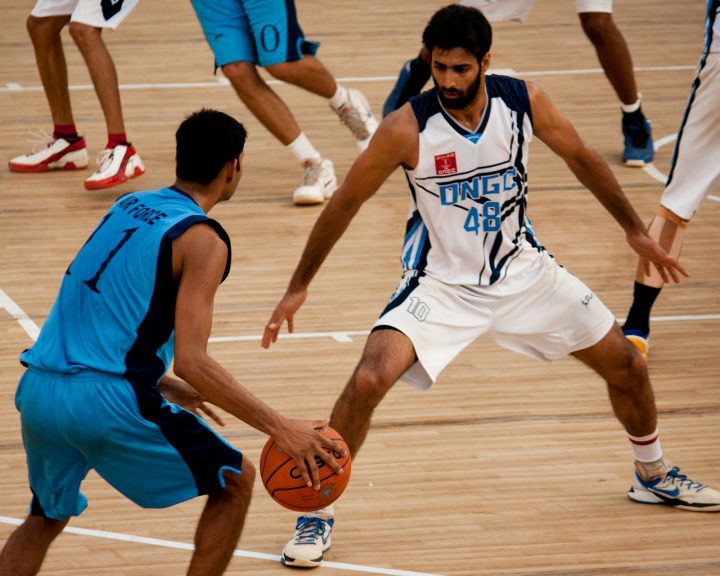Much of strength training is concerned with the vertical application of force. Sit down and stand up in the squat, vertical application. Perform the second pull during the power clean or power snatch, vertical application. Lie down and press a bar off your chest, vertical. Jump as high as possible, vertical. The list goes on.
There is a need for this ability in sports. However, there is also a need to apply force horizontally. Sprinting, agility, throwing, and horizontal jumps are all examples of where this is needed. The challenge is that there are not many tools in the weight room that train the horizontal application of force.
With this post, I’m going to present some thoughts about tools that can be used for training the horizontal application of force to aid sprinting, agility, throwing, kicking, and jumping. This post will look at the following tools:
- Strength training
- Kettlebell swings
- Tires
- Weighted sleds
- Resisted sprinting
- Plyometrics
Strength training:
Developing strength and the fundamental lifts (squat, press, row, hip extension, Olympic lifts) provides a needed foundation for horizontal force application. If a strength foundation exists, then an athlete can be taught how to apply that force horizontally via the other tools that will be covered in this post. In other words, it may not duplicate sprinting, jumping, etc. but heavy basic strength training is critical to success here.
Kettlebell swings:
This is my outside the box thought on this. The classic swing is a curious combination of a vertical movement (knee/hip flexion/extension) and a horizontal one (swinging the kettlebell out and away from the body). When being used for this purpose (as opposed to conditioning), the focus should be on heavier weights and a lower volume, just like a regular strength training exercise that is focused on increasing maximal strength.
Tires:
Flipping large, heavy tires for a distance is all about applying force horizontally. There’s also some sport-specificity here. I understand that we’re not going to pick up tires on a football field, but the techniques used to get under them and then push them are going to be pretty similar to those used in making/resisting contact with another team’s players. There’s a few downsides with this tool. First, it’s difficult to add/reduce the weight of the tire. Second, it requires a tremendous amount of space to both store the tire and to employ it. Third, there’s a big learning curve here.
Weighted sleds:
Pushing or pulling a weighted sled is another example of a tool that teaches an athlete to apply force horizontally. Unlike tires, the weight can be increased or reduced on the sled. The sled can be pushed/pulled for varying distances, which can add to the level of difficulty. The challenge here is when it comes to sprinting and a weighted sled. With more than 10-15% of bodyweight added, sprinting technique breaks down. When you start talking about a lot more than 10-15% of bodyweight, the movement isn’t resembling sprinting anymore (head down, slumped, low to the ground, incomplete hip extension, etc.). This leads to the development of bad habits. So for most athletes, if the intent is to use this as a slow pushing/pulling exercise then it’s a great tool, if it’s to improve sprinting speed then there are probably better tools.
Resisted sprinting:
Resisted sprinting adds some type of weight to make the sprinting motion more difficult. We can use sleds for resisted sprinting, we can also use weighted vests, elastic cords, parachutes, etc. In all cases, care needs to be taken with this approach as too much weight causes sprinting mechanics to break down, possibly teaching the athlete bad sprinting habits. For me, this is a tool that has application in the training of sprinters – but is probably not for everyone else.
Plyometrics:
Horizontal jumps, bounds, and medicine ball throws are great tools to teach the horizontal application of force. They take the strength developed by strength training and teach the athlete to apply it in the appropriate direction.
- Standing jumps: Jumps performed from a standing start. The long jump, triple jump, and jumping over a box can be done this way.
- Jumps with a run-up: This is an attempt to harness the velocity developed by the run-up and translate it to the jump. Could be done for a distance or for a number of steps.
- Bounds: One way to focus bounds on horizontal force application is to attempt to complete a specific distance in as few foot contacts as possible.
- Throws
Strength training and plyometrics are my favorite tools for developing this quality, though there is certainly room in someone’s toolbox for everything else. There’s nothing wrong with using heavy kettlebell swings in conjunction with heavy strength training. Tires and sleds could almost be used interchangeably (one session tires, one session sleds). For a sprinter, resisted sprinting is going to be most appropriate during special preparation and the pre-season if they are not responding to other training modes. For all athletes, plyometrics can be used year-round. Below is an example of putting all this together.
| Monday | Tuesday | Wednesday | Thursday | Friday | |
| Strength Training | Kettlebell swings, 3×4-6Back squats, 3×4-8×80-90%Romanian deadlifts, 3×4-8
Bench press, 3×4-8×80-90% Bent-over rows, 3×4-8 Military press, 3×4-8 |
Power snatch, 3×3-6×60-70%Snatch pulls, 3×3-6×60-70%Power clean + split jerk, 3×3+2×60-70% | Off | Front squats, 3×6-10×70-80%Lunges, 3×8-12 each legGood mornings, 3×8-12
Reverse hyperextensions, 3×12-15 |
Incline press, 3×8-12×70-80%Pull-ups, 3×8-12Military press, 3×8-12
Biceps/triceps, 3×8-12 |
| Speed | Technique drills, 10-15 minutes3x5 meters3x20 meters | Technique drills, 10-15 minutesBounds, 3×20 meters3x40 meters | |||
| Plyometrics | Standing long jump, 10x | Vertical jump, 10xBox jumps (onto box), 10x | Standing triple jump, 10xBox jumps (over box), 10x | MB Throws, 15-20 minutes | |
| Conditioning | Circuit (kettlebell, jump rope, core training, 20-30 minutes) | ||||
| Other tools | Tires or weighted sled, 100 meters total |


